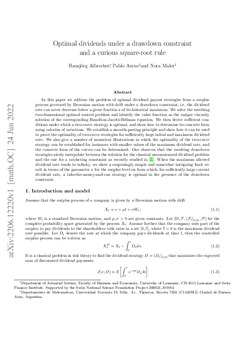Optimal dividends under a drawdown constraint and a curious square-root rule
Metadata
Show full item recordAuthor/s:
Azcue, Pablo
Muler, Nora
Albrecher, Hansjörg
Date:
2023Abstract
In this paper we address the problem of optimal dividend payout strategies from a surplus
process governed by Brownian motion with drift under a drawdown constraint, i.e. the dividend
rate can never decrease below a given fraction a of its historical maximum. We solve the resulting
two-dimensional optimal control problem and identify the value function as the unique viscosity
solution of the corresponding Hamilton-Jacobi-Bellman equation. We then derive su cient conditions
under which a two-curve strategy is optimal, and show how to determine its concrete form
using calculus of variations. We establish a smooth-pasting principle and show how it can be used
to prove the optimality of two-curve strategies for su ciently large initial and maximum dividend
rate. We also give a number of numerical illustrations in which the optimality of the two-curve
strategy can be established for instances with smaller values of the maximum dividend rate, and
the concrete form of the curves can be determined. One observes that the resulting drawdown
strategies nicely interpolate between the solution for the classical unconstrained dividend problem
and the one for a ratcheting constraint as recently studied in [1]. When the maximum allowed
dividend rate tends to in nity, we show a surprisingly simple and somewhat intriguing limit result
in terms of the parameter a for the surplus level on from which, for su ciently large current
dividend rate, a take-the-money-and-run strategy is optimal in the presence of the drawdown
constraint.
Este documento es una versión del artículo publicado en Finance Stochastics 27, 341–400 (2023)
URI:
https://repositorio.utdt.edu/handle/20.500.13098/11842https://doi.org/10.1007/s00780-023-00500-6
https://doi.org/10.48550/arXiv.2206.12220

